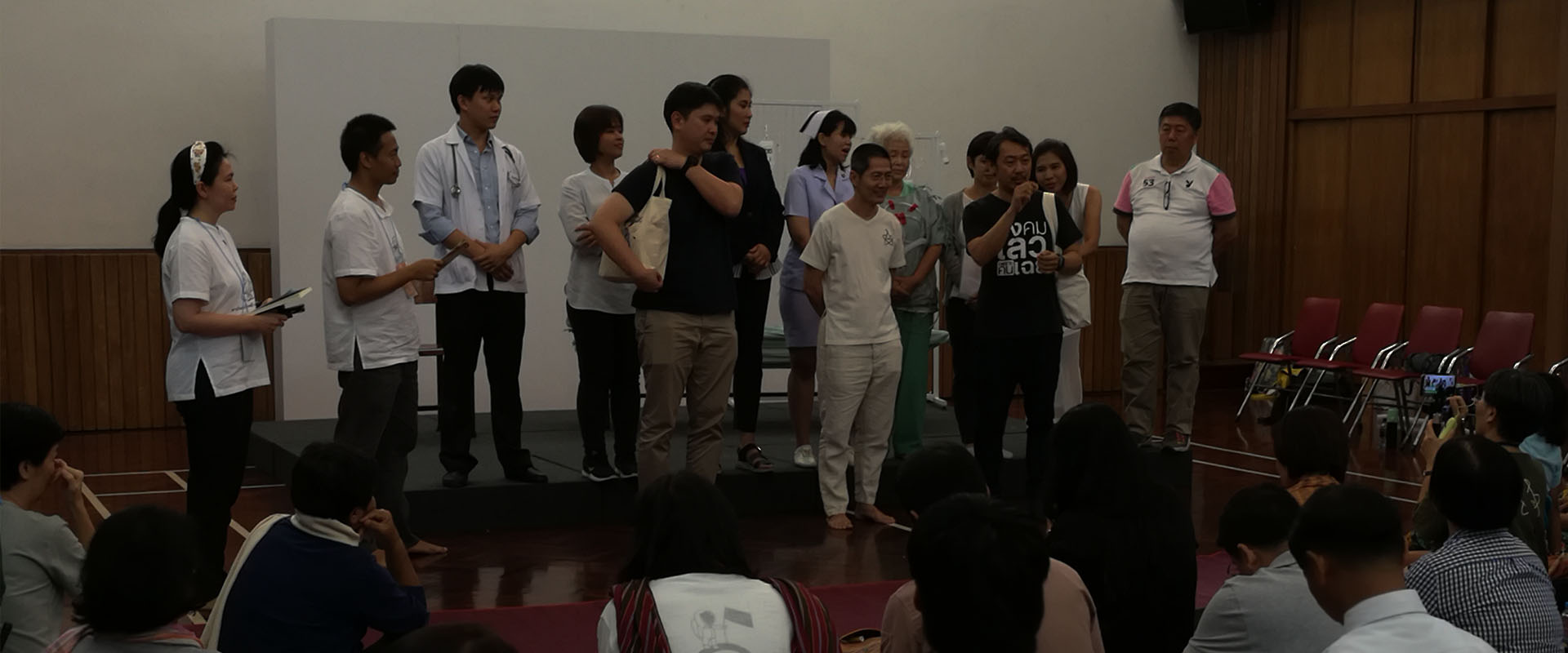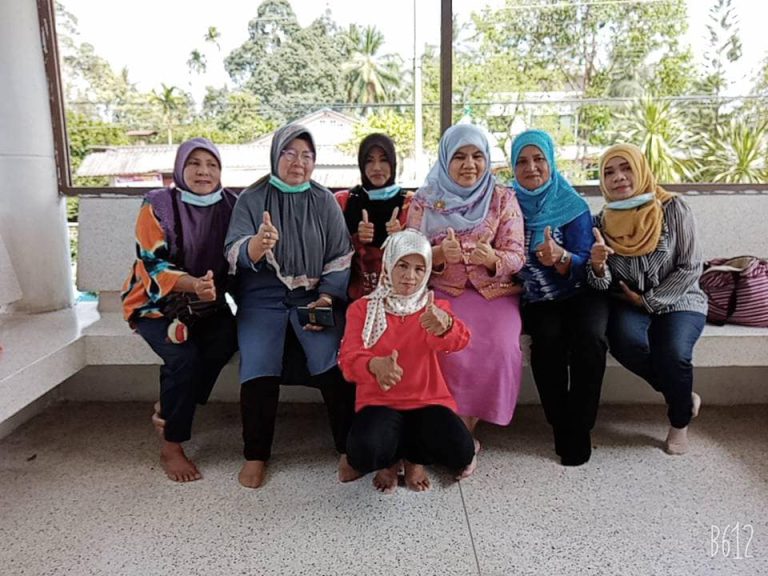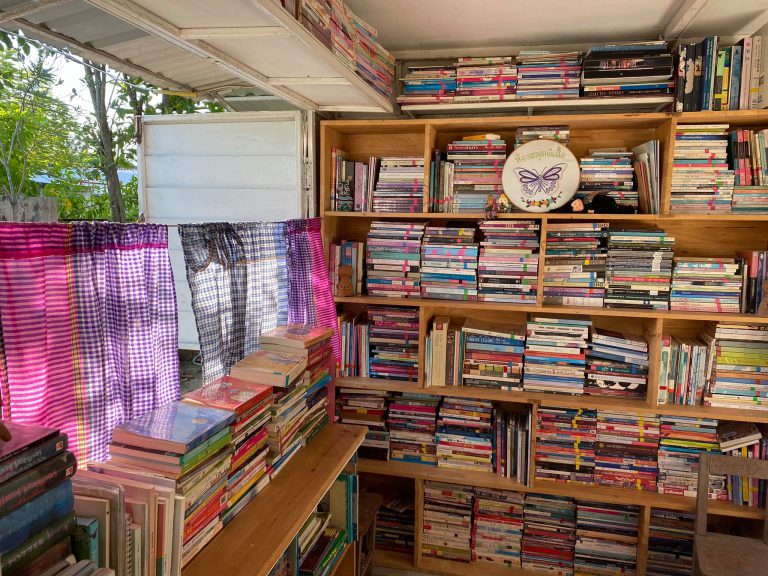Story: Patwajee Srisuwan
On the 15th of September 2018, I had the opportunity to take part in I SEE You contemplative care #1. The event revealed a tight-knit and gentle community that had coalesced out of its members’ shared interest in life and death. Many outsiders may wonder how this community came to be and has continued to sustain itself, when it is fundamentally centered on sickness, suffering and death, which most people consider rather unpleasant.
Arunchai Nithisuphon, or “Pi Chai”, a light-skinned and lithe man with an ever-present smile on his face, appearing as the mind-mannered man in a video of hospital visits that was screened before the event began, can perhaps provide the best portrait of the founding and operations of the I SEE You community.
Inspired by his encounter with Phra Kanchit Akinjano, the abbot of Wat Weerawongsaram in Muang Chaiyaphum referred to as “Phra Ajarn” and a pioneer of a foundation that integrates monks, hospitals and the community in nurturing the spiritual well-being of chronically-ill and terminally-ill patients, Arunchai dedicated himself to the creation of the I SEE YOU community for raising public awareness of end-of-life care until it has become the community it is today.
I spoke to Pi Chai for about an hour after the event to get a clear picture of the past, present and future of the I SEE YOU community and Pi Chai’s own journey, as its leader. We talked about the key factors that allowed the I SEE YOU to come to be in a short span of time, and ensure that it has continued to be a strong and close-knit community into the present.

A Different Mindset Can Be Life-Changing
Before I SEE YOU, I had my own business. After meeting Phra Ajarn Kanchit, I realized that I had been preoccupied with money-making, and that this was not the answer to life. I decided to quit my business to care for my ailing father. My father was already 99 years old then, and a price can not be put on my ability to be fully present for the last three years of my father’s life.
Usually, my buddhist practice would be one thing, taking care of his father another, but I found myself bringing my mindfulness practice into my caregiving. My father was old but strong and had looked after himself well, but I soon learned that this was not enough. Phra Ajarn’s teachings improved my ability to care for his father and they better answered my own and my father’s respective needs.
Once my father passed away with dignity, I became even more convinced that this was it, and that I wouldn’t hesitate any longer. When someone has to pass away, they should have what my father had. If I hadn’t met Phra Ajarn Kanchit, I might have been able to tend to my father to a certain extent, but as a result of meeting him and Ajarn Kampol (Thongboonnoom), I had an understanding of the last stage of life and how to interact with someone who is approaching the end, which made me much more confident. It also inspired me to take up this work.

From the Provinces to the Capital
One of the first things I did was to shadow Phra Ajarn Kanchit when he organised events at local hospitals. When we arranged training courses at hospitals, we brought in village public health volunteers and monks. We organize the event in anticipation of diminishing attendance; if we have 80 people show up on the first day, we’ll have 30 left on the last.
At the beginning I didn’t think I would come this far; I was just following Phra Ajarn’s instructions. Later, once I’d been working in the provinces for a while, I began thinking that people in the city like me don’t have village public health volunteers, nor are there any surviving community structures. So I wanted to do something for the residents of Bangkok, because I am one myself. If I was able to successfully care for my father, then other residents of Bangkok should be able to as well.
Then one day I went to a meeting at the National Archives of Thailand to discuss the staging of a play called “Jittanakorn” (2014). Once I saw that the National Archives were giving other organisations access to their spaces, I asked Phra Ajarn whether he wanted to organize something there, and he responded with “that’s great”.
I told him, “I don’t have anyone else with me. It’s just me”.
“Don’t worry about it, I’ll help you,” he responded.
He brought in colleagues from the provinces to help with the project. That’s when I realized that if I wanted to make anything happen in Bangkok, I would need a team, and that’s how the I SEE YOU community came to be.

More Than Helping Others… Volunteers Must Better Themselves
I attended a teacher training course with the JitArsa’s Bank, and when it came to building my own team, I drew entirely from the team-organizing strategies from the JitArsa course. They introduced us to different tools and techniques that imbued volunteering with more meaning than merely helping others; instead, they transformed volunteering into a practice of self-betterment. It is to practice the buddhist way on the ground, as opposed to attending a lecture on buddhism. It’s dynamic. I asked Phra Ajarn to interweave this toolkit into his own courses on religious practice, which ultimately evolved into a curriculum titled “Dharma for Healing Patients’ Spirits”. We’ve taught it eight times, organising a course twice a year, with me as the leader. As for others interested in teaching the curriculum, such as The Young Buddhists Association of Thailand, Thai Airways and other members of the public, I’m happy for them to do so if there is enough demonstrated interest. At the moment, I have Phra Ajarn Kanchit, Pi Guea (Gueachit Khaeram) and Joon (Asst. Prof. Dr. Jitaweena Mahakita) as my team, which is steadily growing.
From the beginning, when I decided that I wanted to help patients, to seeing I SEE YOU grow into a sangha for learning the proper way to give care, without overstepping boundaries, belittling and overruling what isn’t wanted, I think it’s been an approach of integrity. I haven’t deviated from the traditional dharmic teachings and the buddhist practice.
If I were to follow the buddhist way in the traditional manner, self-betterment would be an individual practice, absent of relationships with other people which are vital to life. From my patient visits I have learned that just because someone wants to isolate themselves doesn’t mean that they should. Sometimes they are taking flight in the face of their problems. This has given I SEE YOU meaning in every respect, and allowed me to better understand my own life and the lives of others. I feel lucky that this series of events has brought me here, and that I have been able to reach out to others and inspire them to do the same.

“Strike the Iron While It’s Hot”: The I SEE YOU Community’s Strengths
An important feature of our community is that we don’t discard training after the initial course. After a month the effects of the training may begin to fade and we return to our previous habits. We gradually fold trained individuals into our community so that they are able to keep practicing with regularity. At the beginning, I was completely clueless; I didn’t have connections to any of the hospitals in the city. Now, we are working with six hospitals who have invited us to visit their patients.
We receive part of our education through the training course, but if we do not put what we have learned to practice, we won’t be able to transform anything. Trainees are still in the mindset of “I know what should be done but I can’t do it”. Once we bring them on hospital visits, they internalize what they have learned, and realize where they make mistakes in a real-world setting. As homework after the visit, we ask them to narrate their day and reflect on what they have learned, which is optional, according to what each participant is capable of committing. I’ve seen how powerful storytelling can be.
There are usually 40 participants in a training course, and the majority will go on hospital visits. However, some may only do one, and choose to observe for the rest. There tends to be 5-10 highly committed participants in each course; once we begin organising more consistent programming, we may introduce 20 engaged members to our community in a year. In addition to the hospital visits, we have a biannual community meeting, and I SEE YOU STRONG programming, such as community-building workshops, to continue to bring together our active community members.
We’ll continue to keep grinding and we won’t stop (he laughs). If we’ve found a powerful momentum, it’d be a waste to throw it away — we have to “strike while the iron is hot”. Suppose we train and then wait for 2-3 months before calling everyone to action, that’s too large an interval that’s gone by. Recently, we’ve started building connections with hospitals, and we share our progress in a closed line group chat, to create excitement and keep people from drifting away. We have around 200 members in our line group; few are vocal, most prefer to observe. However, they show up when we have an event, and that’s how we slowly become a community.

“Creating Space” and “Building Trust”
Many variables led to the formation of the I SEE YOU community, but one of the most important was that everyone involved was in a process of self-discovery and self-questioning. During their first encounter with and training in the community’s framework for caregiving, it was like they had entered a space in which they could be themselves, free of the pressure to be anything else for those two days. I don’t expect everyone who goes through our training to become active members and join our hospital visits.
What is most important is trust. Though we may get lost or make mistakes at times, with trust, we still manage to find our way back. For example, this is the first time we are organizing an event like this. In the past, I would have been really stressed, but for this event, I practiced taking a step back and allowing my younger colleagues to assume bigger roles, which is hard for me. I’m an (enneagram) type 3 — a perfectionist and results-driven.
So, I had to work on myself for this event. If I approach our work as an experience I will learn from, neither will I fixate on what is right or wrong, nor neglect efficacy. If I reassure myself that “it’s okay to make mistakes”, and tell myself and my younger colleagues that “mistakes are not something to be afraid of, in fact making a mistake is cute,” then we all get to keep improving.
From before, when I was a one man show, doing everything myself because I was convinced that I was highly accomplished, always right and a good person, I’ve since learned a lot. This is what I think is one of the secrets that has sustained the I SEE YOU community to this day: to allow others to make the same mistakes that I made. I wasn’t able to get to this place before because I couldn’t accept that mistakes happen and allow them to happen. As a result, I was stressed and uptight, but nowadays I’ve learned that the opportunity to make mistakes is much more cool.

A Project for the Future… We Want to See People Learn to Love Each Other
I created the “The Course for Changing One’s Life” because I want to see a future where we can love one another; I want to see people have the opportunity to genuinely communicate with one other from the heart. Which, at a certain point, I’ve found to be very easy. I was sure that within three days I would be able to bring them to the threshold of opening the door to their hearts. I consider it a success if I can help one person love themself. It doesn’t have to involve sickness — even relationships in families without a sick member will to this day be marked by resentment, anger and a lack of communication. I can see these patterns shaping a path that will bring them to an end, and whether this end will be easy or difficult.
Phra Ajarn Paisal teaches that how we live is how we die. If today you are not okay, if that is how you are now with the confusion ahead only growing, if you do not learn to take a step back to ground yourself and become aware of the fact that you aren’t in a good place… if no one helps you understand, then you will continue to think that what you are doing is right and good, that you are doing the best you can… but that’s not true. Over these three days, you’ll see that things can be even better than what you understand as you trying your best.
The pillar of this three day course is mindfulness, without relying on buddhist terminology. Mindfulness is a matter of relationships. In Phra Ajarn’s section of the course, he talks about mindfulness in laymen’s terms, in a manner that easy to understand and incorporate in daily life.
“The Course for Changing One’s Life” sounds like one of those courses that are priced at ten thousand baht, but we do ours for free. People who attend those expensive courses say that they are amazing, but in two to three months they revert back to the familiar habits that hurt their loved ones. However, we won’t let you forget so easily; we provide an ‘after sales service’ as well.

An Organisation That Does Not Want For (Money and) Capital
The first time I organized a lecture delivered by a monk, I paid out of my own pocket for all expenses. Phra Ajarn was concerned, but I didn’t feel like I was overreaching much. After the second, third, fourth time, it began to gain momentum. Nowadays, I sell shirts, and when I give lectures I put my earnings into the central fund. The fund has since grown so large that I have been able to print 7000 copies of a book (The Nurse Who Dissects a Dead End by Kuejit Khaeram) and distribute them for free.
The money from our tshirt sales and every extra baht is gainfully used. I know the value of money, and I won’t let it run out. These days, I don’t have to say anything; countless people give donations. I take the stance of not turning away any goodwill, but I don’t accept so much as to feel awkward.
It’s true what they say: the more we give the more we receive. If I set limits, I receive no more than that. If I am not discriminating, I receive every time, which makes me all the more confident of this path. Furthermore, our hospital visit initiative will be partnered with a social enterprise in the future to bring in a new source of funding, which we can discuss further at our next meeting.

Important people mentioned: Arunchai Nithisuporn
Picture credits: Phatwajee Srisuwan, I SEE U Contemplative Care fanpage on Facebook



